Pulling down the chickenheads in Kings Canyon California
20-24 July 2002
Pulling down the chickenheads in Kings Canyon California
20-24 July 2002
Hal Murray, Chris Hibbert and I decided to climb the Obelisk by its longest route, the West Face. Gene Miya had done it and reported that the climbing was fun and easy and that there were chickenheads everywhere. That sounded good to us, so we hit the road. The only problem was the ten mile backpack in to basecamp before we even reached the climb.
We stopped at the forest service office to get our wilderness permit, then drove up the grade above Tollhouse to the Wishon reservoir. We drove across the one-lane road on top of the dam then a few miles further taking the right fork when the road split to the Crown Valley Trailhead just before the road crossed Rancheria Creek. We pulled in at 5 PM due to a late start since I was exhausted after 4 weeks of teaching 6 hours a day. The parking lot had three bear boxes which we used as tables as we packed the food for the trip. Loading up our personal packs with: the climbing gear, a liter of water each and the 6 pounds of food apiece packed in two bear cans, our packs weighed in at 48 pounds. Heavy but bearable. We finally got on the trail at 6 PM and hiked uphill nearly three miles before finally entering the John Muir Wilderness where Stratham Creek enters Rancheria Creek. We camped far off the trail just before the trail started to go uphill. I was beat. I had a cold and was having trouble breathing. I wondered if I would be able to go on in the morning or if I would have to retreat to the car to read for the next few days.
I felt a little better the next day and so decided to continue on toward the mountain. Hal had forgotten his bivy sack in the car so he ran back down to the trailhead giving me two more hours of sleep. He said he knew I was sick because for once he got up before I did. The trails were empty. We only met three other backpackers as we ate lunch. When we told them we were going to climb the Obelisk, they thought we were crazy. But they took our picture for us anyway.
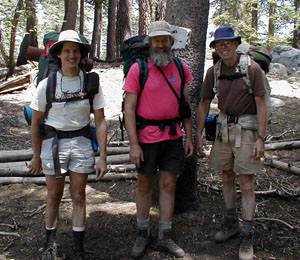
We climbed up a ridge and then descended the trail toward the Geraldine Lakes. On the way down we found some nice gleaming white granite boulders and stopped for a bit to climb. The three backpackers passed us as we were climbing and just shook their heads, they knew we were crazy. We climbed up toward the higher Geraldine lake and then pushed on to the smallest highest Geraldine Lake where we found a fine campsite. As we settled in, strange brown clouds blew overhead and obscured the sun. I knew that those were the clouds produced by a forest fire. I feared it might be just over the ridge from us, and I was glad we had a lake nearby. In the morning we found out the fire had erupted and grown quite large on Sunday and that it was tens of miles southwest of us.
We slept in until 7 AM and then ate breakfast and headed for the Obelisk. We contoured to the north a short ways until we came to the trail in the gully that led up from Lower Geraldine Lake. We followed the trail to the ridge. To our left rose a long flat topped pile of dark gray volcanic rock. I led the team through grassy meadows paralleling the south face of this rock pile. We climbed a little bit up and over the pile near its end and saw the Obelisk in all its glory, the west face looked like an arete. We were excited by the chance to climb it. We continued hiking up across meadows to the peak above the Obelisk then dropped down to the base of the rappel which we planned to use to exit the summit. It had taken an hour and a half to get to the Obelisk from camp. We changed in to climbing gear, ate snack food and tanked up on water. Then we headed downhill along the northwest face of the rock. An amazing rock wall towered over us as the scrambled down the boulders finding a path that minimized bushwhacking. Near the bottom we passed through a notch formed by a large boulder and the main rock and arrived at the Chimney that marks the base of the climb. We never saw the spring that is supposed to be beneath this face.
Chris and I flipped a coin to determine who got to lead first, Hal declined saying he was waiting for the higher chickenhead studded pitches. Hal noted that the first ascent was by Fred Beckey, so that we should expect the climb to be hard for its grade of 5.7. We soon found out that he was wrong, the climb was easy for 5.7.
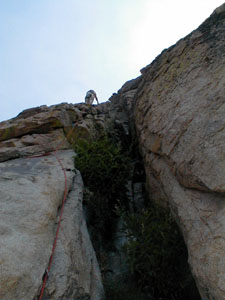
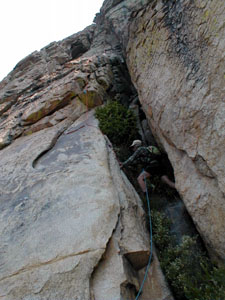
We started climbing at 10:22. Chris found that the rock was solid and well textured with holds and cracks. He stopped at a good ledge about 150 feet up. Hal followed then I joined them and reached out to pick up the rack so that I could lead. I was shocked to find it wasn't ready yet, I guess we were out of practice a bit. I began to revise my estimate that we would take 30 minutes a pitch. I reassembled the rack, then it was my turn to lead. I led up just left of the steep wall that forms the right edge of the west face. The holds were plentiful. I ran it out 20 feet between pieces of protection because the climbing felt so solid. I knew that the next pitch was supposed to climb the steep wall on the right and so I kept looking for possible exits. I came to a wide slot and noted three routes up, so I stopped in the slot. Chris and Hal soon came up to join me. The next time I would belay above this slot.

Then it was Hal's turn to lead. He turned down my first two routes which involved overhangs and made his was up the steep wall ahead. After moving up the steep wall for twenty feet or so he traversed right ending up on top of the overhangs. Stepping right on small holds on steep rock was the crux of the climb. When I arrived last at the belay I was handed the rack and offered the next lead. I accepted the offer and led up steep rock in the sun. It felt good to get onto warm rock after the shady cold of the initial pitches.
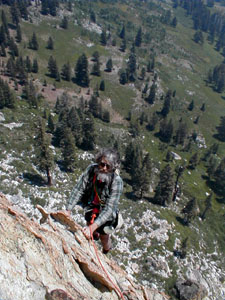
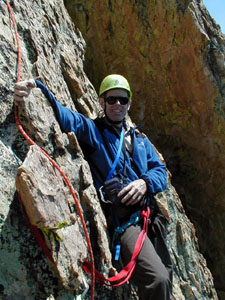
The climb was full of good holds. But it was long. I was glad we had been climbing at the gym week after week to keep in shape. Hal suggested that we should start carrying packs while climbing in the gym to help us get in better shape for real climbs. We drank water and ate snacks lightening the packs as we climbed, we also were wearing most of our clothes since the wind kept things cool.
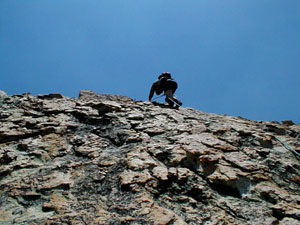
Route finding was not much of a problem, we just kept going up and finding great rock. A couple of times a hold would snap off in our hands, reminding us to be careful, and also telling us that this route did not get much traffic. We used lots of tied off chickenheads for protection. I reminded Chris that there were four orientations to choose among for each tied off knob. The slip knot could go on the right or the left, and the end of the loop that pulled the cinch tight could be toward the rock or away from it. I told him that I tried to find the orientation for each chickenhead that would tighten the sling under load. These chickenheads were so good that almost any tie-off worked well.

The steep wall continued above, and so did the large holds. Hal loves steep bucket holds so he had a big smile as he led the fifth pitch. He stayed left of the small ceiling that diagonalled up to the right, and this turned out to be the correct move.
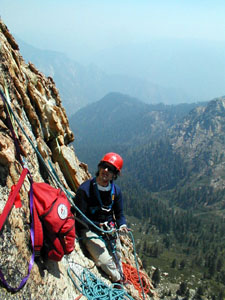
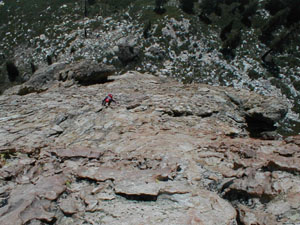
Looking down from high on the route. We came up to the
climbers left of the tall tower with the shadowy groove behind
it.
At the end of pitch 6 we encountered a broken up jumble of blacks. I put in a short lead through these blocks and set up a belay for the final lead by Chris. The wall above looked smoother that the wall below. However I noted that the wall below often had ten times more holds that we actually needed, so that an order of magnitude reduction in the number of holds was just fine.
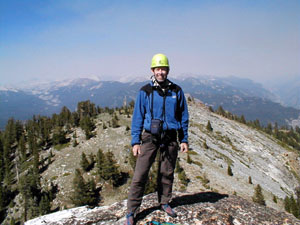
We reached the summit by 4 PM having taken 45 minutes a pitch for the 8 pitches (71/3?) of climbing. The summit register showed that we were the sixth party of 2002 to reach the summit, we were also the sixth party in July. We ate some snacks, drank water and generally enjoyed the view. The lighting was strange due to a smoky fire to the southwest.
As Paul Morgan says we were done with the difficult part of the climb, now we had to do the dangerous part. The descent from the Obelisk requires two rappels and the second rap is one of the most interesting ones I have done. We headed down to the east and traversed around to the north to the upper rap anchors. We rappelled off of 3 fine bolts about 60 feet to a ledge with three more bolts. Then we rigged two ropes together to do the long final rap to the ground. The last time Hal was here 20 years ago and even when I was here last there was a rappel rope tangled among the chickenheads to the climbers left of the rap route. Someone had cleaned this tangle, but its memory lingered on as a warning to us all. Chickenhead covered faces eat ropes.
The lower rappel goes free for a while. I enjoyed slowly spinning around getting a view of the Sierra as I descended.
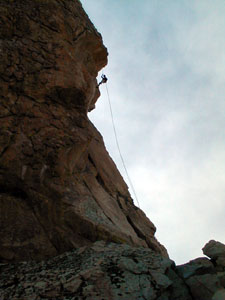
Hal moved the knot down 10 feet so that it was past all the entangling chickenheads then became the last in our party to rappel. We all got down, then I hiked up the nearby summit to the north and was able to pull the rope out away from the wall so that it fell freely. Hooray.
"It's not over til it's over," is what the fat lady sings. There was still some exposed traversing to do to climb all the way down to the ground and our packs. We climbed down to the east and north and found a route with good handholds, and good exposure.
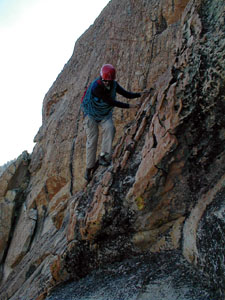
When we reached our packs we ate lunch and freed our feet from the climbing boots. Aah!
Then we shouldered our packs and hiked back to camp. This time we hiked along the summit of the broken volcanic ridge. We encountered some bushwhacking, but we also got great views of the climb.
We returned to camp for dinner and went to bed happy. To quote Hal,"What a great day!"
Tuesday we hiked out to the car. We left camp at 8 PM and got to the car by 2 PM. True to ourselves however we stopped along the way in Geraldine lakes valley to enjoy some more bouldering.
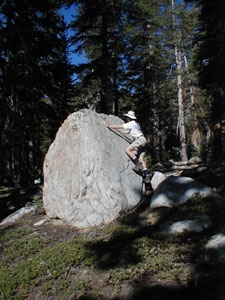
There are more climbs on the Obelisk, rated 5.8 and 5.9, the rock is so good I have to return and climb all of them.
|
Scientific Explorations with Paul Doherty |
|
25 July 2002 |